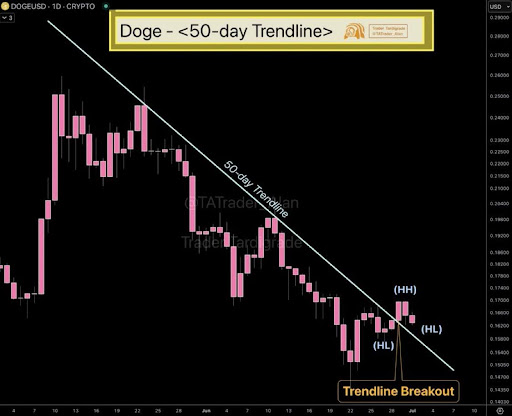
How Bitcoin affects Bitcoin ETFs value, and types of Bitcoin ETF types
Today, dated June 18, 2024, Bitcoin stands at $ 65,681.76.
We already explained and discussed the workings of a Bitcoin ETF in our previous blog, “How Bitcoin ETFs Make Crypto Accessible for All.” Bitcoin ETFs are like other
Exchange-Traded Funds (ETFs) traded on exchanges. They allow traditional investors to invest in Bitcoins and make profits without owning any.
In this blog, we’ll explore how the value of Bitcoin affects the price of a Bitcoin ETF and the different types of Bitcoin ETFs that exist. So, let’s begin.
ETF shares v/s Bitcoin Prices
The performance of Bitcoin has a significant impact on the value of Bitcoin ETF’s shares. This means that the value of Bitcoin ETF shares is adjusted in line with the movement of Bitcoin price, providing a clear link between the two.
Market makers constantly buy and sell ETFs to maintain a sync between ETF shares and Bitcoin prices, balancing supply and demand. For instance, if the price of ETFs starts deviating from the actual price of Bitcoin, the market makers actively step in and restore the equilibrium, making a profit in the process.
Different Types of Bitcoin ETFs
So far, Bitcoin ETFs have been differentiated into three different types:
- Physical Bitcoin ETF
- Spot Bitcoin ETFs
- Future-based Bitcoin ETFs
So, let’s understand each Bitcoin ETF’s differences, pros, and cons so you can make a better decision when purchasing one.
Physical Bitcoin ETF
The physical Bitcoin ETF is a direct ownership approach, enabling investors to expose themselves to the actual Bitcoin. This form of Bitcoin ETF investment opportunity eliminates storage concerns, enabling a transparent structure for investors seeking simpler Bitcoin investments.
One of the major advantages of this physical Bitcoin ETF is the straightforward ownership of the Bitcoin; the issuer holds physical custody. However, investors in physical Bitcoin ETFs must be aware of the storage cost of the asset and the chance of loss of anonymity. Usually, the expense ratios of physical ETFs vary from 0.24% to 1.5%.
Spot Bitcoin ETF
In Spot Bitcoin ETF, the fund that holds the Bitcoin on behalf of the investors tracks the crypto’s market value. They also tie the crypto to the current market value. Investors are allowed to sell or buy ETFs as per the real-time prices, giving them better exposure.
One of the biggest risks involved in Spot Bitcoin ETFs is the cryptocurrency market’s inherent volatility, which largely affects their value. Amid such uncertainties, investors must opt for a strategic approach and analyze the potential fluctuations and rapid price changes of the asset. Poplar firms like Valkyrie, BlackRock, and Wisdom Tree have introduced the spot Bitcoin ETFs; they often charge considerable brokerage commissions and management fees.
Bitcoin Futures ETFs
Bitcoin Futures ETFs, or derivatives-based Bitcoin ETFs, are a completely unique form as they draw their value from Bitcoin Futures contracts, not particularly through asset holding. However, similar to the synthetic Bitcoin ETF, future-based ETFs offer an indirect investment with lower exposure to crypto.
Futures ETFs usually track the buy and sell agreements, analyzing the price movements. As these ETFs offer an approach for exposure, they are also subject to market volatility, which is often associated with futures trading, like contango and backwardation.
Thus, it is vital for investors to understand the kind of risk future contracts bring while dealing with Future-based Bitcoin ETFs. This makes it more suitable for those investors who are experienced and comfortable with the risk involved with market fluctuations.
But, out of these three types, Spot Bitcoin ETF is still the most considered one. Let’s observe why spot Bitcoin is a big deal.
Why is Spot Bitcoin ETF a big deal?
Spot Bitcoin ETF is considered a significant development, especially in the cryptocurrency space. Let’s explore the reasons:
- Adopted by the mainstream: Since their acceptance by regulatory bodies and listing on exchanges, Spot Bitcoin ETFs have been adopted by a wide variety of investors, including institutional investors. Individuals who have been sceptical or hesitant about investing in cryptocurrencies are readily investing in Spot Bitcoin ETFs. Thus, Spot Bitcoin ETF is contributing to the increased adoption of Bitcoin as an investment asset.
- Approved by regulatory bodies: The Spot Bitcoin ETFs have been approved by the Securities and Exchange Commission (SEC). This gives an additional layer of oversight and legitimacy to the cryptocurrency markets, and it could even lead to more acceptance and regulatory clarity for other cryptocurrencies.
- More convenient and accessible: The Spot Bitcoin ETF is an easy way for retail investors to get exposure to Bitcoin while ignoring the technical challenges involved in wallet management and private key security. This makes them a more user-friendly investment vehicle.
- Market maturity: Spot Bitcoin ETFs are proof that the cryptocurrency market has matured enough to support regulated and standardized investment products. This will attract more institutional capital and enhance market stability.
Endnote:
Right now, Bitcoin ETFs can be considered one of the most significant tools for investing in crypto while avoiding the complex technicalities and risks associated with cryptocurrencies. Spot Bitcoin ETFs have already been approved by major regulatory bodies, like the US SEC, which makes them a more secure investment and also opens gates for other cryptocurrencies, paving the way for larger crypto adoption in the near future.




